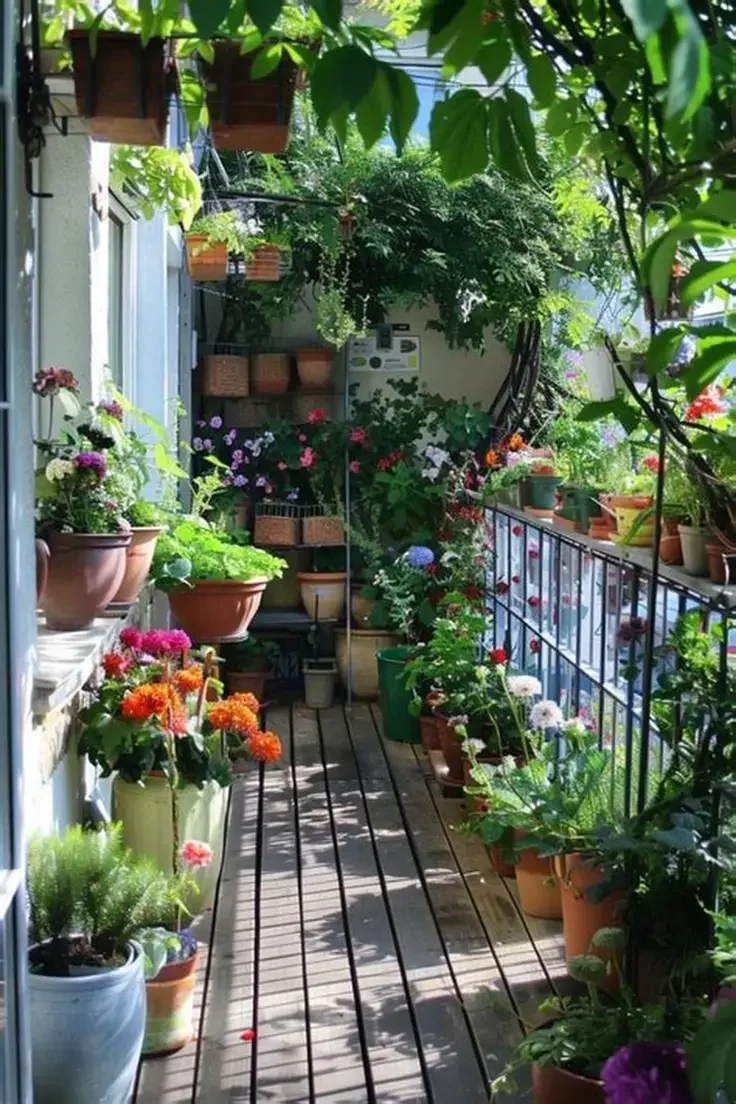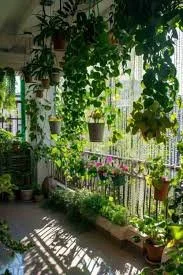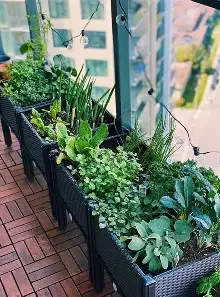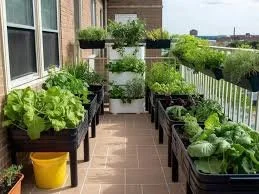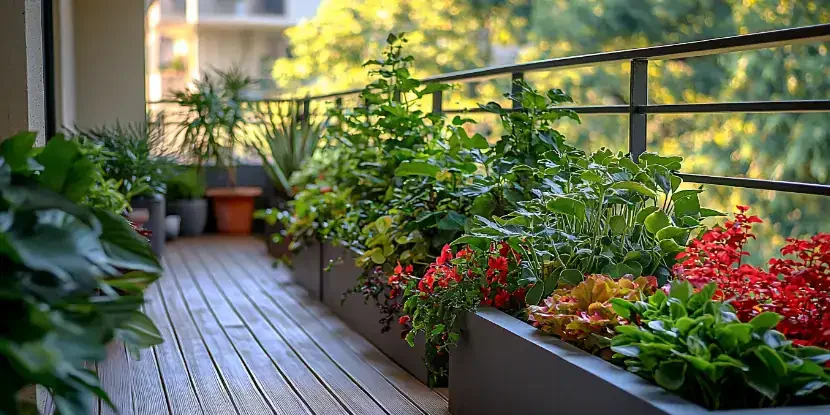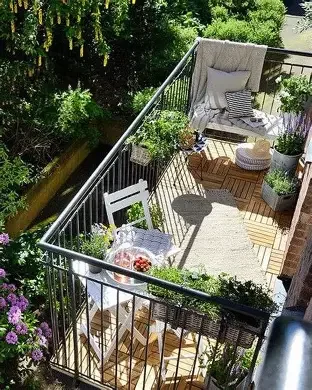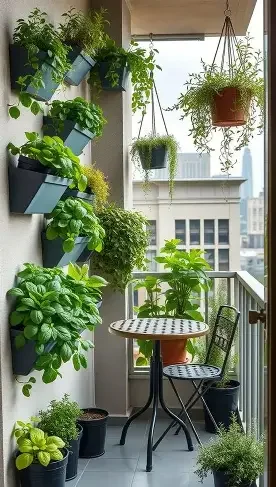Balcony Gardening: A Practical Guide for Small-Space Growers
Balcony gardening is both an art and a science that involves cultivating plants in compact, elevated outdoor spaces, which are often found attached to apartments, studios, or townhouses. This practice requires a blend of horticultural techniques and spatial design, allowing individuals to grow a variety of plants in areas where traditional ground access may be limited.
What sets balcony gardening apart is not just its practicality but its ability to enhance urban living. It has evolved from being a passing trend into a meaningful lifestyle change that promotes ecological awareness, personal wellness, and aesthetic enhancement. By integrating greenery into their living spaces, individuals can contribute to improving air quality, attracting pollinators, and fostering biodiversity in their urban environments.
Moreover, balcony gardening offers numerous benefits for mental health and well-being. Tending to plants can be a calming and grounding experience, providing a sense of accomplishment and connection to nature. This practice encourages mindfulness and can serve as a creative outlet for those looking to express themselves through their choice of plants and design.
From vibrant flowers and aromatic herbs to fresh vegetables and fruit, the variety of plants that can thrive in these compact spaces is extensive. With the right techniques, such as vertical gardening or the use of containers, even small balconies can be transformed into lush green havens. Ultimately, balcony gardening embodies a holistic approach to living that harmonizes the natural world with urban life, making it a valuable pursuit for city dwellers seeking a touch of nature in their everyday lives.
🌞 **Environmental Considerations for Balcony Gardens**
Balcony gardens are uniquely influenced by their specific microclimates, which play a crucial role in their overall success and sustainability.
Sunlight Exposure: The direction your balcony faces significantly impacts the amount of sunlight your plants receive. For example, east-facing balconies bask in soft morning light, which is ideal for delicate plants that flourish in milder conditions. Conversely, west-facing balconies are subjected to the intense heat of the afternoon sun, making them suitable for sun-loving species that thrive in warmer temperatures.
Wind Intensity: The strength and direction of wind currents can greatly influence both plant selection and the stability of containers. Strong winds may necessitate the choice of hardier plants that can withstand such conditions, as well as secure, weighted pots to prevent tipping or damage.
Rainfall and Drainage: The patterns of rainfall and the effectiveness of your balcony's drainage system are key to determining your garden's watering needs. Proper allocation of pots—whether they require drainage holes for excess water or the ability to retain moisture—is essential for maintaining healthy plant growth.
By understanding these environmental factors, you can make informed decisions about resilient plant species and create thoughtfully designed layouts that will thrive in your unique balcony garden setting.
Selecting Plants That Fit Your Space
Balcony gardening is not just about what you can grow—it’s about what makes sense for your space, lifestyle, and design goals. The key is to match plant choices to your balcony’s light conditions, available space, and intended use. Here’s how to curate a plant palette that’s both functional and beautiful.
| Design Intent | Recommended Plants | Light Requirements | Container Suggestions | Design & Care Notes | ||||||||||||||||||
|---|---|---|---|---|---|---|---|---|---|---|---|---|---|---|---|---|---|---|---|---|---|---|
| Edible Garden |
Herbs: Basil, mint, parsley, coriander, thyme, rosemary, chives Leafy Greens: Lettuce, spinach, arugula, kale, Swiss chard Fruiting Plants: Cherry tomatoes, chili peppers, strawberries, dwarf eggplants, okra Root Vegetables: Radishes, baby carrots, spring onions, beetroot Climbers: Beans, peas, passionfruit, cucumbers (with trellis) |
Full sun to partial shade (4–6+ hrs) | Rail planters, crates, deep pots, grow bags, hanging baskets | Use organic compost; rotate crops seasonally; group by water needs | ||||||||||||||||||
| Privacy & Screening | Bamboo, lemongrass, papyrus, tall ornamental grasses, climbing jasmine, golden pothos | Full sun to partial shade | Vertical planters, trellises, large pots, railing boxes | Wind-tolerant; creates visual buffer; prune to maintain height | ||||||||||||||||||
| Shade-Friendly | Ferns, begonias, peace lilies, caladium, snake plant, spider plant, ZZ plant | Low light / full shade |
| Light Level | Plant Types | Examples | Care Notes |
|---|---|---|---|
| Full Sun (6+ hrs) | Fruiting plants, herbs, pollinator flowers, tropical accents | Tomatoes, rosemary, lavender, chili peppers, strawberries, dwarf eggplants, okra, marigolds, salvia, zinnias, cosmos, sunflowers, hibiscus, crotons, cordyline | Use deep pots or grow bags; water regularly; rotate containers to ensure even exposure; ideal for balconies with southern or western orientation |
| Partial Shade (3–5 hrs) | Leafy greens, soft herbs, fragrant plants, climbers, medicinal roots | Mint, lettuce, parsley, coriander, thyme, impatiens, scented geranium, jasmine, lemon balm, beans, peas, cucumbers, turmeric, ginger, oregano | Best in east-facing balconies or shaded zones; use ceramic pots for moisture retention; mulch to reduce evaporation; avoid midday sun |
| Full Shade (0–2 hrs) | Ornamental foliage, low-light tropicals, air-purifying plants | Ferns, caladium, snake plant, spider plant, ZZ plant, peace lilies, golden pothos | Mist regularly; avoid overwatering; ideal for north-facing balconies or covered alcoves; pair with reflective surfaces to brighten space |
| Bright Indirect Light | Tropical accents, flowering shrubs, sensitive herbs | Gardenia, curry leaf, dwarf banana, heliconia, Swiss chard, arugula | Filter light with sheer fabric or trellises; fertilize monthly; protect from wind and direct afternoon sun |
🧺 Container Compatibility
When selecting containers for your plants, it’s essential to consider their root systems to ensure optimal growth.
Shallow-rooted plants:, such as fragrant herbs and tender lettuce, flourish in wide and shallow trays. These containers allow their roots to spread comfortably and access moisture easily without becoming waterlogged.
Deep-rooted plants:, like hearty tomatoes and robust bamboo require taller pots that provide sufficient depth for their extensive root systems. These containers should have excellent drainage to prevent water accumulation, which can lead to root rot.
Climbing plants:, including the vibrant passionflower and graceful morning glory, benefit from trellises or railing supports. These structures give them the vertical space they need to reach for the sun, while also allowing their tendrils to latch on and grow upward.
Maintenance Tip: To help maintain the health of your plants and reduce the frequency of watering, consider choosing containers with built-in reservoirs that can retain moisture longer. Alternatively, applying a layer of mulch can help keep the soil moist by reducing evaporation, ensuring your plants remain hydrated and thriving.
📐 Matching Plant Size to Your Space
For Small Balconies: Opt for compact herbs like basil or thyme, vibrant succulents, and delicate trailing vines that can be beautifully displayed in hanging baskets or railing planters. These smaller plants can bring life and color without overwhelming the space.
For Medium Balconies: Take advantage of tiered shelving to create a dynamic garden filled with a mix of plants. Consider combining edibles such as strawberries or cherry tomatoes with ornamental flowers and plants that serve as privacy screens, adding both beauty and functionality to your outdoor area.
For Large Balconies: Transform your expansive space with stunning container trees, such as dwarf citrus, that can add height and fragrance. Modular raised beds can provide a lush, layered look, while incorporating seating arrangements surrounded by greenery offers a perfect spot to relax and enjoy your urban oasis.
Layout Suggestion: To create visual interest and depth, adopt a triangular grouping technique. Position a tall plant as your focal point, surround it with medium-sized fillers, and let trailing plants cascade over the edges. This arrangement not only enhances rhythm but also adds texture and charm to your balcony garden.
🌧️ Rainfall & Drainage
Rain access varies widely:
Some balconies are fully exposed and receive direct rainfall.
Others are covered or recessed, requiring manual irrigation.
💧 Drainage Considerations:
Ensure pots have proper drainage holes and saucers.
Elevate containers slightly to prevent waterlogging.
Use lightweight, well-draining soil mixes to reduce compaction.
🧪 Design Tip: Incorporate a drip irrigation system or self-watering containers for consistent moisture control, especially in covered balconies.
🌬️ Wind Intensity
Wind as a Design Element: Challenges and Opportunities
Wind can pose significant challenges in balcony design, especially in high-rise settings where gusts tend to be more pronounced. On such balconies, the strong winds can dry out the soil quickly, which can lead to water stress for plants and ultimately threaten their health. Moreover, the harsh conditions can damage delicate foliage, making it crucial to select appropriate plant species that can withstand these environments.
On the other hand, balconies that are more sheltered may encounter their own set of issues. The reduced airflow can lead to trapped humidity, creating a perfect environment for fungal growth and attracting pests. This balance of air circulation is vital in keeping plants healthy and thriving.
Effective Solutions for Wind and Humidity Management:
To tackle these challenges effectively, consider the following strategies:
1. Plant Selection: Opt for wind-tolerant plants that can flourish despite the strong gusts. Good choices include ornamental grasses, which add visual appeal and resilience, as well as rosemary, known for its hardiness. Bamboo is another excellent option that can not only withstand wind but also provide a striking aesthetic.
2. Sturdy Planters: Use heavy ceramic or concrete pots for your plants. These materials offer stability and help anchor the plants against strong winds, reducing the risk of them toppling over. Furthermore, the weight of these planters helps maintain soil moisture levels, which is essential for healthy plant growth.
3. Windbreaks Installation: Consider installing windbreaks such as lattice panels or vertical gardens. These structures can effectively buffer airflow, creating microzones that offer more stable conditions for your plants. Not only do they help manage wind exposure, but they can also provide a visually appealing design element for your balcony.
By thoughtfully addressing the impact of wind on high-rise balconies, you can create a vibrant and healthy green space that thrives in its unique environment.
High-rise balconies often experience strong gusts that dry out soil and damage delicate foliage.
Sheltered balconies may trap humidity, encouraging fungal growth or pests.
🪴 Solutions:
Choose wind-tolerant plants like ornamental grasses, rosemary, or bamboo.
Use heavy ceramic or concrete pots to anchor plants.
Install windbreaks—like lattice panels or vertical gardens—to buffer airflow and create microzones.

